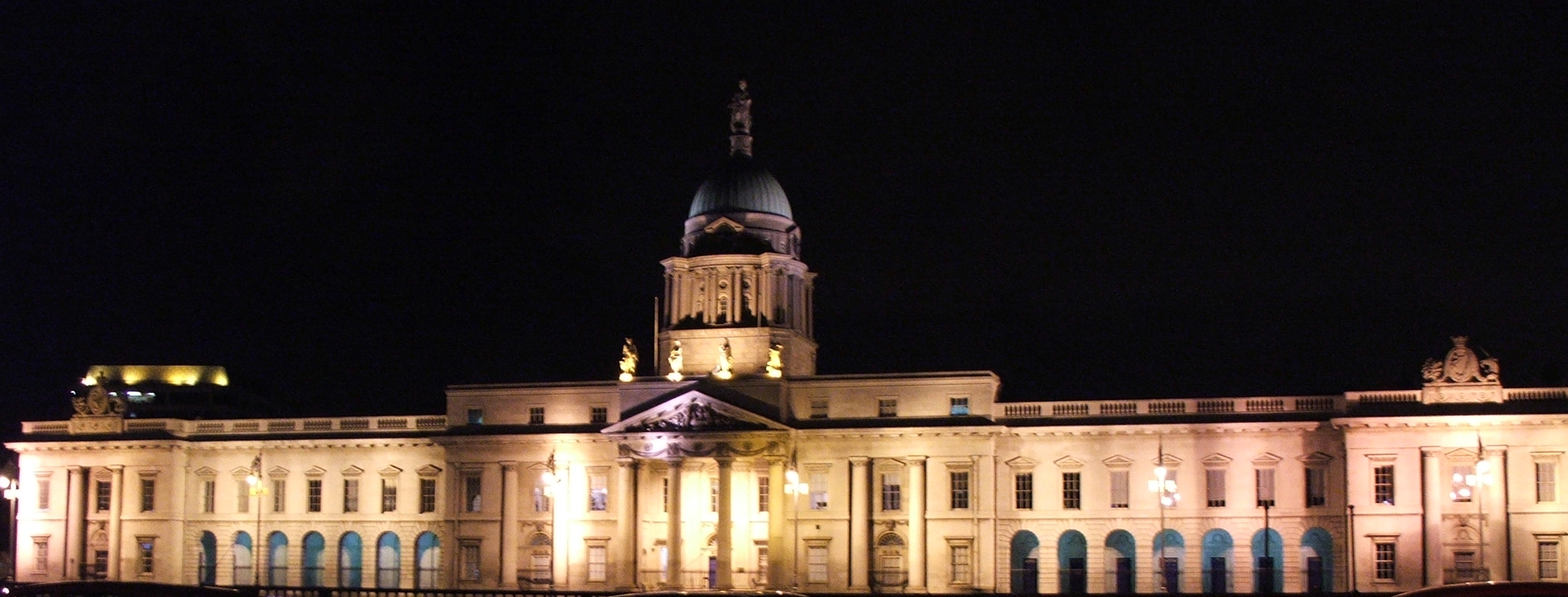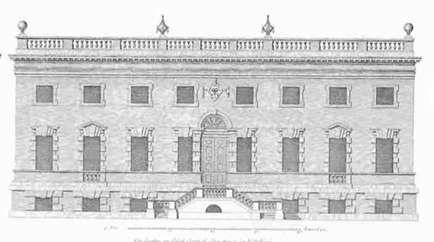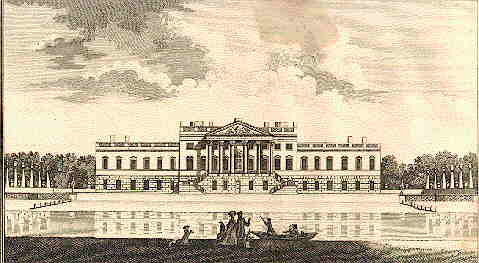|
James Gandon
James Gandon (20 February 1743 – 24 December 1823) was an English architect best known for his work in Ireland during the late 18th century and early 19th century. His better known works include The Custom House and the surrounding Beresford Place, the Four Courts and the King's Inns in Dublin and Emo Court in County Laois. Early life Gandon was born on 20 February 1742 in New Bond Street, London, at the house of his grandfather Peter Gandon, a French Huguenot refugee. He was the only son of Peter Gandon (b. 1713), a gunmaker, and Jane Burchall (possibly née Wynne). From 1749 he was educated at Shipley's Drawing Academy where he studied the classics, mathematics, arts and architecture. On leaving the drawing academy he was articled to study architecture in the office of William Chambers (architect), Sir William Chambers. Chambers was an advocate of the neoclassicism, neoclassical evolution of Palladian architecture, although he later made designs in the Gothic Revival style ... [...More Info...] [...Related Items...] OR: [Wikipedia] [Google] [Baidu] |
New Bond Street
Bond Street in the West End of London links Piccadilly in the south to Oxford Street in the north. Since the 18th century the street has housed many prestigious and upmarket fashion retailers. The southern section is Old Bond Street and the longer northern section New Bond Street—a distinction not generally made in everyday usage. The street was built on fields surrounding Clarendon House on Piccadilly, which were developed by Sir Thomas Bond. It was built up in the 1720s, and by the end of the 18th century was a popular place for the upper-class residents of Mayfair to socialise. Prestigious or expensive shops were established along the street, but it declined as a centre of social activity in the 19th century, although it held its reputation as a fashionable place for retail, and is home to the auction houses Sotheby's and Bonhams (formerly Phillips) and the department store Fenwick and jeweller Tiffany's. It is one of the most expensive and sought after strips of re ... [...More Info...] [...Related Items...] OR: [Wikipedia] [Google] [Baidu] |
Wombourne
Wombourne is a large village and civil parish located in the district of South Staffordshire, in the county of Staffordshire, England. It is 4 miles (6 km) south-west of Wolverhampton and just outside the county and conurbation of the West Midlands. Local services are run by a parish council. At the 2001 census it had a population of 13,691, increasing to 14,157 at the 2011 Census. Etymology and usage The Old English word ''burna'' signifies a stream, and a stream is a notable feature of the village. Formerly the village name was thought to mean "Womb Stream", or stream in a hollow, because this is a reasonable description of the situation. However, more recent scholarship explains the name as meaning a Crooked Stream, which is at least as good a description. ''Burna'' was one of the terms for a stream used in the earliest Anglo-Saxon place names, and the stream was presumably itself called the Wom Bourn. However, today it is always distinguished from the village by ... [...More Info...] [...Related Items...] OR: [Wikipedia] [Google] [Baidu] |
John Dawson, 1st Earl Of Portarlington
Earl of Portarlington is a title in the Peerage of Ireland. It was created in 1785 for John Dawson, 1st Earl of Portarlington, who had earlier represented Portarlington in the Irish House of Commons. He was the son of William Dawson, 1st Viscount Carlow, who had represented Portarlington and Queen's County in the Irish House of Commons, and had been created Baron Dawson, of Dawson's Court in the Queen's County, in 1770, and Viscount Carlow, in the County of Carlow, in 1776. These titles were also in the Peerage of Ireland. The first Earl was succeeded by his eldest son, the second Earl. He was a Colonel in the 23rd Light Dragoons but disappeared the night before the Battle of Waterloo and thus missed the start of the battle. He then attached himself to the 18th Hussars, but after the battle was forced to resign his commission in disgrace, fell into dissipation and 'died in an obscure London slum'. He never married and was succeeded by his nephew, the third Earl. He was the ... [...More Info...] [...Related Items...] OR: [Wikipedia] [Google] [Baidu] |
Saint Petersburg
Saint Petersburg ( rus, links=no, Санкт-Петербург, a=Ru-Sankt Peterburg Leningrad Petrograd Piter.ogg, r=Sankt-Peterburg, p=ˈsankt pʲɪtʲɪrˈburk), formerly known as Petrograd (1914–1924) and later Leningrad (1924–1991), is the second-largest city in Russia. It is situated on the Neva River, at the head of the Gulf of Finland on the Baltic Sea, with a population of roughly 5.4 million residents. Saint Petersburg is the fourth-most populous city in Europe after Istanbul, Moscow and London, the most populous city on the Baltic Sea, and the world's northernmost city of more than 1 million residents. As Russia's Imperial capital, and a historically strategic port, it is governed as a federal city. The city was founded by Tsar Peter the Great on 27 May 1703 on the site of a captured Swedish fortress, and was named after apostle Saint Peter. In Russia, Saint Petersburg is historically and culturally associated wi ... [...More Info...] [...Related Items...] OR: [Wikipedia] [Google] [Baidu] |
Romanov
The House of Romanov (also transcribed Romanoff; rus, Романовы, Románovy, rɐˈmanəvɨ) was the reigning imperial house of Russia from 1613 to 1917. They achieved prominence after the Tsarina, Anastasia Romanova, was married to the First Tsar of Russia, Ivan the Terrible. The house became ''boyars'' (the highest rank in Russian nobility'')'' of the Grand Duchy of Moscow and later of the Tsardom of Russia under the reigning Rurik dynasty, which became extinct upon the death of Tsar Feodor I in 1598. The Time of Troubles, caused by the resulting succession crisis, saw several pretenders and imposters ( False Dmitris) fight for the crown during the Polish–Muscovite War of 1605–1618. On 21 February 1613, a '' Zemsky Sobor'' elected Michael Romanov as Tsar of Russia, establishing the Romanovs as Russia's second reigning dynasty. Michael's grandson Peter I, who established the Russian Empire in 1721, transformed the country into a great power through a seri ... [...More Info...] [...Related Items...] OR: [Wikipedia] [Google] [Baidu] |
Dublin Custom House 2
Dublin (; , or ) is the capital and largest city of Ireland. On a bay at the mouth of the River Liffey, it is in the province of Leinster, bordered on the south by the Dublin Mountains, a part of the Wicklow Mountains range. At the 2016 census it had a population of 1,173,179, while the preliminary results of the 2022 census recorded that County Dublin as a whole had a population of 1,450,701, and that the population of the Greater Dublin Area was over 2 million, or roughly 40% of the Republic of Ireland's total population. A settlement was established in the area by the Gaels during or before the 7th century, followed by the Vikings. As the Kingdom of Dublin grew, it became Ireland's principal settlement by the 12th century Anglo-Norman invasion of Ireland. The city expanded rapidly from the 17th century and was briefly the second largest in the British Empire and sixth largest in Western Europe after the Acts of Union in 1800. Following independence in 1922, Dublin becam ... [...More Info...] [...Related Items...] OR: [Wikipedia] [Google] [Baidu] |
Royal Academy
The Royal Academy of Arts (RA) is an art institution based in Burlington House on Piccadilly in London. Founded in 1768, it has a unique position as an independent, privately funded institution led by eminent artists and architects. Its purpose is to promote the creation, enjoyment and appreciation of the visual arts through exhibitions, education and debate. History The origin of the Royal Academy of Arts lies in an attempt in 1755 by members of the Society for the Encouragement of Arts, Manufactures and Commerce, principally the sculptor Henry Cheere, to found an autonomous academy of arts. Prior to this a number of artists were members of the Society for the Encouragement of Arts, Manufactures and Commerce, including Cheere and William Hogarth, or were involved in small-scale private art academies, such as the St Martin's Lane Academy. Although Cheere's attempt failed, the eventual charter, called an 'Instrument', used to establish the Royal Academy of Arts over a d ... [...More Info...] [...Related Items...] OR: [Wikipedia] [Google] [Baidu] |
Colen Campbell
Colen Campbell (15 June 1676 – 13 September 1729) was a pioneering Scottish architect and architectural writer, credited as a founder of the Georgian style. For most of his career, he resided in Italy and England. As well as his architectural designs he is known for ''Vitruvius Britannicus'', three volumes of high-quality engravings showing the great houses of the time. Early life A descendant of the Campbells of Cawdor Castle, he is believed to be the Colinus Campbell who graduated from the University of Edinburgh in July 1695.page 7, Catalogue of the Drawings Collection of the Royal Institute of British Architects: Colen Campbell, John Harris 1973, Gregg International Publishers Ltd He initially trained as a lawyer, being admitted to the Faculty of Advocates on 29 July 1702. He travelled in Italy between 1695 and 1702, and is believed to be the Colinus Campbell who signed the visitor's book at the University of Padua in 1697. He is believed to have trained in and studi ... [...More Info...] [...Related Items...] OR: [Wikipedia] [Google] [Baidu] |
Inigo Jones
Inigo Jones (; 15 July 1573 – 21 June 1652) was the first significant architect in England and Wales in the early modern period, and the first to employ Vitruvian rules of proportion and symmetry in his buildings. As the most notable architect in England and Wales, Jones was the first person to introduce the classical architecture of Rome and the Italian Renaissance to Britain. He left his mark on London by his design of single buildings, such as the Queen's House which is the first building in England designed in a pure classical style, and the Banqueting House, Whitehall, as well as the layout for Covent Garden square which became a model for future developments in the West End. He made major contributions to stage design by his work as theatrical designer for several dozen masques, most by royal command and many in collaboration with Ben Jonson. Early life and career Beyond the fact that he was born in Smithfield, London, as the son of clothworker Inigo Jones Snr., a ... [...More Info...] [...Related Items...] OR: [Wikipedia] [Google] [Baidu] |
Vitruvius Britannicus
Colen Campbell (15 June 1676 – 13 September 1729) was a pioneering Scottish architect and architectural writer, credited as a founder of the Georgian style. For most of his career, he resided in Italy and England. As well as his architectural designs he is known for ''Vitruvius Britannicus'', three volumes of high-quality engravings showing the great houses of the time. Early life A descendant of the Campbells of Cawdor Castle, he is believed to be the Colinus Campbell who graduated from the University of Edinburgh in July 1695.page 7, Catalogue of the Drawings Collection of the Royal Institute of British Architects: Colen Campbell, John Harris 1973, Gregg International Publishers Ltd He initially trained as a lawyer, being admitted to the Faculty of Advocates on 29 July 1702. He travelled in Italy between 1695 and 1702, and is believed to be the Colinus Campbell who signed the visitor's book at the University of Padua in 1697. He is believed to have trained in and studi ... [...More Info...] [...Related Items...] OR: [Wikipedia] [Google] [Baidu] |
John Woolfe (architect)
John Woolfe (23 March 1932 – 14 June 1969) was a British racing driver from England, who specialised in sports car racing. He was killed as a result of crashing on the first lap of the 1969 24 Hours of Le Mans race, an event which caused the traditional " Le Mans start" to be abolished the following year. Career Woolfe was born in London. He was a gentleman driver, and had several years' experience of racing sports cars. He formed his own team, John Woolfe Racing, with his business partner, Arnold Burton, and in 1968 he bought a Chevron B12, specially adapted to be fitted with a Repco V8 engine, similar to the unit which had won the Formula One World Championships in and . Woolfe was successful in domestic racing, and also entered several international races. The climax of his season was the 1968 24 Hours of Le Mans, where he entered himself alongside Digby Martland, but retired after only 27 laps, persistent overheating problems causing an engine failure. He also o ... [...More Info...] [...Related Items...] OR: [Wikipedia] [Google] [Baidu] |
Nottingham
Nottingham ( , locally ) is a city and unitary authority area in Nottinghamshire, East Midlands, England. It is located north-west of London, south-east of Sheffield and north-east of Birmingham. Nottingham has links to the legend of Robin Hood and to the lace-making, bicycle and tobacco industries. The city is also the county town of Nottinghamshire and the settlement was granted its city charter in 1897, as part of Queen Victoria's Diamond Jubilee celebrations. Nottingham is a tourist destination; in 2018, the city received the second-highest number of overnight visitors in the Midlands and the highest number in the East Midlands. In 2020, Nottingham had an estimated population of 330,000. The wider conurbation, which includes many of the city's suburbs, has a population of 768,638. It is the largest urban area in the East Midlands and the second-largest in the Midlands. Its Functional Urban Area, the largest in the East Midlands, has a population of 919,484. The popula ... [...More Info...] [...Related Items...] OR: [Wikipedia] [Google] [Baidu] |









